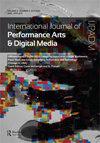电视舞台:或如何在疫情中创建剧院——项目报告
IF 0.9
0 THEATER
International Journal of Performance Arts and Digital Media
Pub Date : 2021-12-19
DOI:10.1080/14794713.2021.2015562
引用次数: 5
摘要
摘要本报告介绍了作者的研究项目“电视舞台”,该项目由艺术与人文研究委员会(AHRC)的“新冠肺炎快速反应”计划资助。该项目旨在开发有效且负担得起的新方法,将来自不同家庭的表演者连接起来,并将他们安置在在线虚拟场景中,在那里他们可以一起排练和表演。该报告讨论了远程信息处理表演的历史,并解释了这项研究是如何利用一些既定的方法,为在当前疫情内外工作的剧院和舞蹈公司开辟替代可能性的。到目前为止,该项目已经展示了如何使用一系列远程信息处理镀铬系统,为基于视频会议的表演工作带来全新的创造力,将表演者的身体从Zoom盒子的束缚中解放出来,并将其放在专门设计的3D环境中。根据该项目八个驻地中一些驻地与专业表演团体的案例研究,作者讨论了现有技术如何适应不同水平的经验,以及该项目如何提供新的工作方式。虽然疫情预计将是一个有时间限制的问题,但这些技术对剧院和舞蹈的表演者和创作者来说具有价值,远远超过了“封锁”。本文章由计算机程序翻译,如有差异,请以英文原文为准。
A Telepresence Stage: or how to create theatre in a pandemic – project report
ABSTRACT This report describes the authors’ research project ‘Telepresence Stage’, funded by the Arts and Humanities Research Council’s (AHRC) ‘COVID-19 Rapid Response’ scheme. The project aims to develop effective and affordable new approaches to connect performers from their separate homes and place them within virtual sets online where they can rehearse and perform together. The report discusses the history of telematic performance and explains how this research is using some of those established approaches to open up alternative possibilities for theatre and dance companies working in and beyond the current pandemic. To date, the project has shown how a range of telematic chromakey systems can be employed to bring a whole new level of creativity to videoconference-based performance work, freeing the performers’ bodies from the entrapment of Zoom boxes and co-locating them in specially designed 3D environments. Drawing on case studies from some of the project’s eight residencies with professional performance groups, the authors discuss how existing techniques have been adapted for different levels of experience, and how the project has offered new ways of working. Whilst the pandemic is expected to be a time-limited issue, these techniques hold value for performers and creators of theatre and dance well beyond ‘lockdown’.
求助全文
通过发布文献求助,成功后即可免费获取论文全文。
去求助
来源期刊

International Journal of Performance Arts and Digital Media
Arts and Humanities-Visual Arts and Performing Arts
CiteScore
1.70
自引率
0.00%
发文量
29
 求助内容:
求助内容: 应助结果提醒方式:
应助结果提醒方式:


